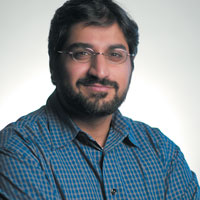
Abstract
Academic papers have routinely reported power per bit numbers in the low pJs for several years. It may be reasonable to assume as an upper limit that deployed systems may achieve the one to two orders of magnitude improvement to reach 0.5 pJ/bit within the next 5 years. These optimistic electrical link estimates still fall short of energy performance required by advanced microprocessors. Here we demonstrate that the current state of photonic devices integrated in foundry CMOS foundry processes are competitive with existing and next generation on-chip power dissipation numbers. The presentation will include device architectures for high-index contrast waveguides, microring resonators, vertical grating couplers, photodetectors and optical modulators that are process compatible with scaled CMOS technology. A summary of the design hierarchy, back-end photonics process, and electronic-photonic system architectures will be presented. Results for photonic integrated circuit within sub-45nm logic CMOS and DRAM process flows will be presented. The application of this new photonic platform to mulitcore processor-to-memory interconnects and Terabit communications will be discussed.
The final portion of the presentation will discuss fundamental limits to the energy per bit for photonic communication. Recent work at MIT on the energy per bit required to generate photons and transmit information will be re-examined. In particular, the recent demonstration of light emitting diodes with far greater than 100% electrical-to-optical wall-plug efficiency will be discussed. These photonic links will be used to explore the relationship of physical entropy in the light and the information theoretic entropy in the optical channel.
Biography
Rajeev J. Ram has worked in the areas of physical optics and electronics for much of his career. In the early 1990’s while a graduate student at UCSB, he developed the III-V wafer bonding technology that led to record brightness light emitting devices at Hewlett-Packard Laboratory in Palo Alto. While at HP Labs, he worked on the first commercial deployment of surface emitting lasers. In the early 1990′s, he developed the first semiconductor laser without population inversion, semiconductor lasers that employ condensation of massive particles, and threshold-less lasers. Since 1997, Ram has been on the Electrical Engineering faculty at the Massachusetts Institute of Technology (MIT) and a member of the Research Laboratory of Electronics. He has served on the Defense Sciences Research Council advising DARPA on new areas for investment and served as a Program Director at the newly founded Advanced Research Project Agency-Energy. At ARPA-e, he managed a research portfolio exceeding $100M and consulted with the Office of Science and Technology Policy and the White House. His group at MIT has developed record energy-efficient photonics for microprocessor systems, microfluidic systems for the control of cellular metabolism, and the first light-source with greater than 100% electrical-to-optical conversion efficiency. His group’s work on small-scale solar thermoelectric generation is being deployed for rural electrification in the developing world as SolSource and was recognized with the St. Andrews Prize for Energy and the Environment.